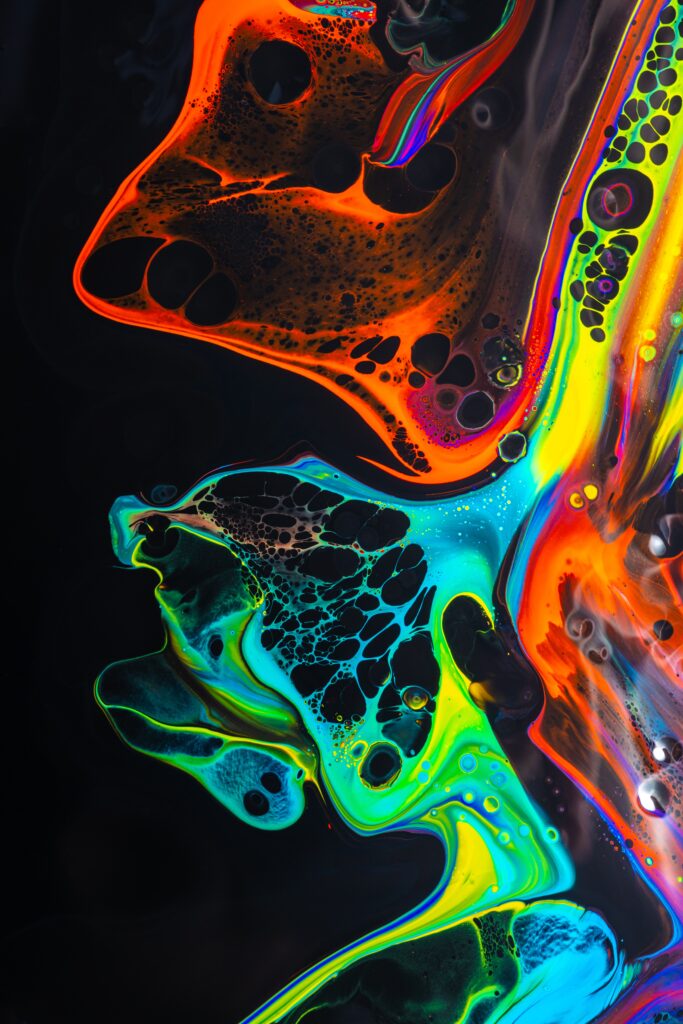Pour Painting
contents
What is pour painting?
How to do pour painting?
What kind of paint is ideal for pour painting?
More affordable paints substitutes for pour painting
What is pour painting?
Pour painting, also known as fluid art or acrylic pouring, is a technique in which acrylic paint is thinned with various mediums and poured onto a canvas or other surface to create abstract patterns and designs.
The method is pouring or dripping paint onto the canvas. And then tilt or manipulate the canvas to allow the paint to flow and spread across the surface. This process creates unique and unpredictable patterns as the colors mix and interact with each other.
The paint mixture typically consists of acrylic paint, a pouring medium (such as a gel or liquid medium that increases the flow and drying time of the paint), and sometimes other additives like silicone oil or water. These additional substances can create interesting effects like cells or marbling.
Pour painting offers a wide range of creative possibilities. Because artists can experiment with different colors, pouring techniques, and additives to achieve desired effects. The end result is often a vibrant and visually striking abstract artwork.

How to do paint pouring?
Here are the general steps for creating a pour painting.
Prepare your workspace: Cover your workspace with a drop cloth or plastic sheet to protect it from paint spills.
- Gather your supplies: You will need
a. acrylic paint, pouring medium,
b. a canvas or other surface to paint on,
c. mixing cups,
d. stir sticks,
e. and a palette knife or other tool for spreading the paint.
- Mix your paint: Mix your paint and pouring medium together in the mixing cups. Follow the instruction according to the instructions on the pouring medium bottle. The consistency of the mixture should be like warm honey.
- Choose your colors: Decide on the colors you want to use for your painting and pour them into separate mixing cups. You can mix colors together to create new shades if you like.
- Pour your paint: Starting with one color, pour a small amount onto the canvas in a zigzag pattern. Add another color on top of the first and repeat until you have used all of your colors. You can also use a tool to spread the paint or create patterns.
- Tilt the canvas: Tilt the canvas in different directions to make the paint flow and blend together. You can also use a palette knife or other tool to help spread the paint.
- Let it dry: Let your pour painting dry completely. The drying time will depend on the thickness of the paint and the humidity in your workspace.
- Finish your painting: You can add additional details or layers to your painting once it is dry, or leave it as is for a beautiful abstract piece.
Remember, pour painting is a fun and experimental process, so don’t be afraid to try new techniques and colors to create your own unique artwo
What kind of paint is ideal for pour painting?
Acrylic paint is the most commonly used type of paint for pour painting. Acrylics are water-soluble, easy to work with, and come in a wide range of colors. They are also fast-drying, which makes them a good choice for pour painting because the paint needs to be fluid for the technique to work.
However, other types of paint can also be used for pour painting. Some artists use oil paints, although they can take a long time to dry and can be more difficult to work with than acrylics. Watercolors and gouache paints can also use for pour painting. But they may not provide the same level of texture and depth as acrylics.
In addition to the type of paint, the consistency of the paint is also important for pour painting. Mixing the paint with a pouring medium or other additives can help create a fluid consistency that is ideal for pour painting.
More affordable paints substitutes for pour painting
If you are looking for a cheap substitute paint for pour painting, you might consider using craft acrylic paints. These paints are often less expensive than artist-grade acrylics, and they come in a wide range of colors.
However, craft acrylics are generally less pigmented and less durable than artist-grade acrylics, which means that the colors may not be as vibrant and the painting may not last as long.
Additionally, craft acrylics may not mix as well with pouring mediums or other additives. And it can affect the fluidity of the paint.
Another option is to use house paint or latex paint, which can be more affordable than artist-grade acrylics. However, these paints are thicker and may need to be thinned down with water or a pouring medium in order to achieve the proper consistency for pour painting.
Using cheaper paints may be a good way to experiment with pour painting. Investing in higher quality artist-grade acrylics can yield better results in terms of color vibrancy, texture, and durability.
